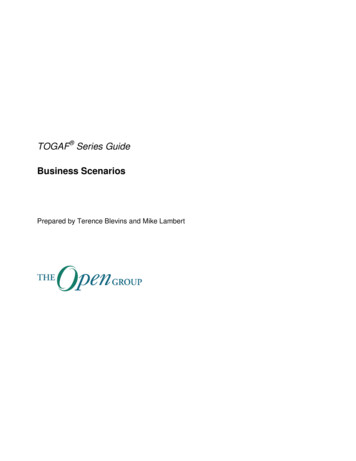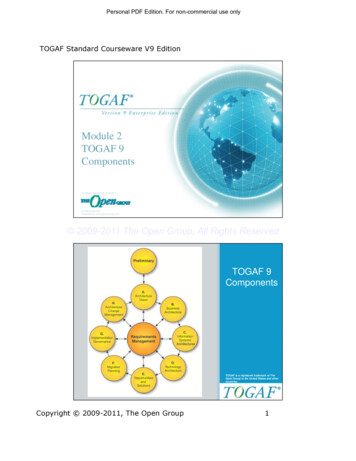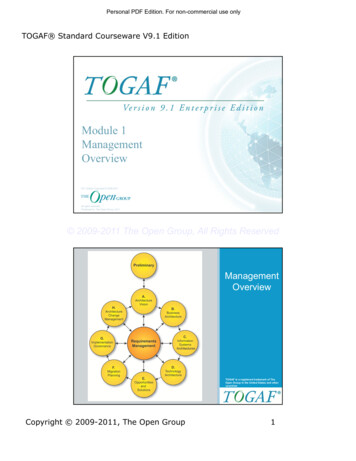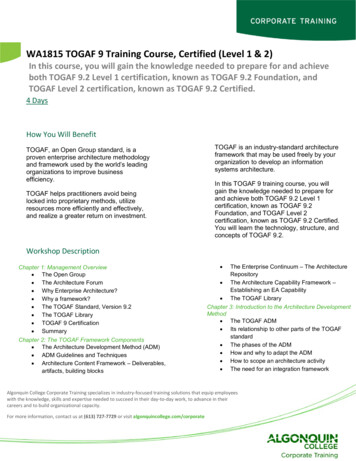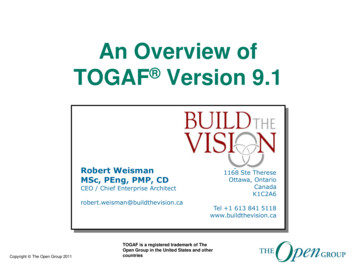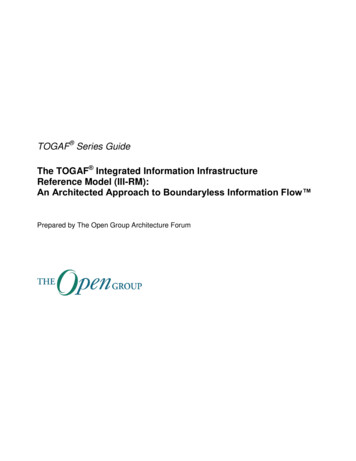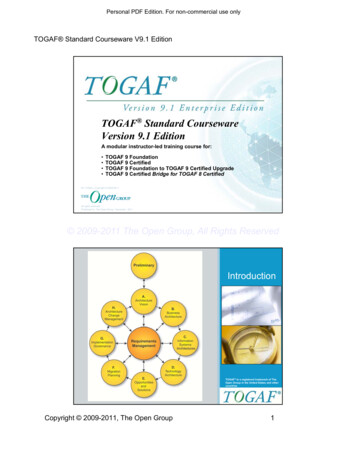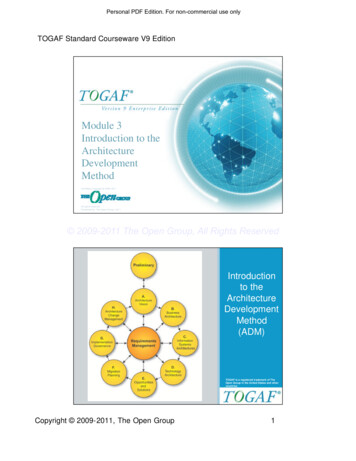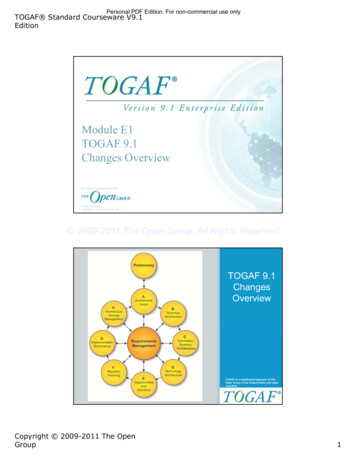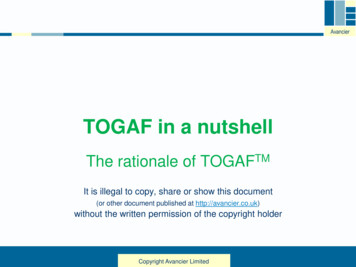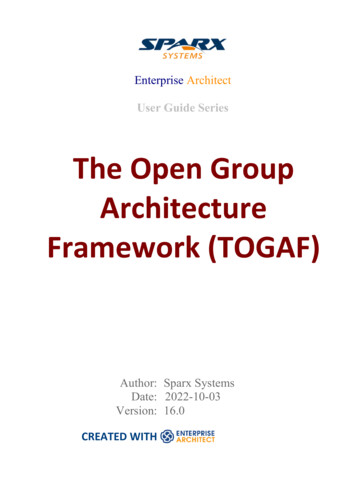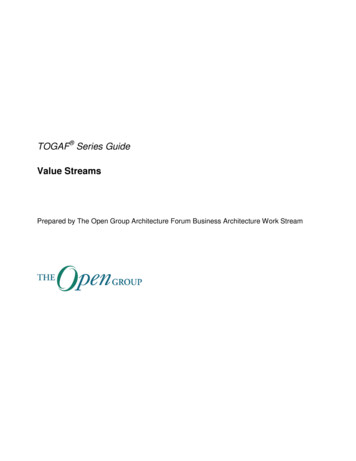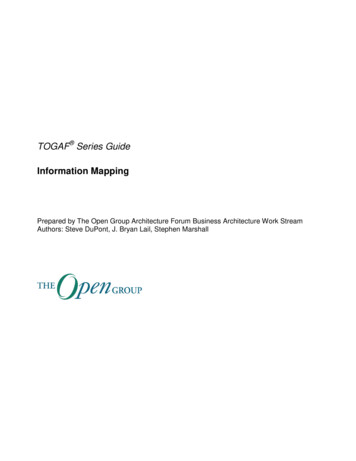
Transcription
TOGAF Series GuideInformation MappingPrepared by The Open Group Architecture Forum Business Architecture Work StreamAuthors: Steve DuPont, J. Bryan Lail, Stephen Marshall
Copyright 2019, The Open Group. All rights reserved.No part of this publication may be reproduced, stored in a retrieval system, or transmitted, in any form or by any means,electronic, mechanical, photocopying, recording, or otherwise, without the prior permission of the copyright owner.This Guide has not been verified for avoidance of possible third-party proprietary rights. In implementing this Guide,usual procedures to ensure the respect of possible third-party intellectual property rights should be followed.TOGAF Series GuideInformation MappingISBN:1-947754-29-4Document Number:G190Published by The Open Group, April 2019.Comments relating to the material contained in this document may be submitted to:The Open Group, Apex Plaza, Forbury Road, Reading, Berkshire, RG1 1AX, United Kingdomor by electronic mail to:ogspecs@opengroup.orgiiTOGAF Series Guide (2019)
Contents1Introduction . 12What is an Information Map? . 23The Impact and Benefits . 34The Relationship to Business Capabilities, Value Streams, andOrganization Maps . 45Distinguishing between Information Maps and Data Models . 66Using Information Maps with the TOGAF ADM . 77Putting Information Maps into Practice . 88Conclusion . 10ARepresentations of Information Maps . 11A.1 ArchiMate Language Example . 11A.2 Unified Modeling Language (UML) . 13A.3 Entity Relationship Diagrams (ERDs) . 15Information Mappingiii
PrefaceThe Open GroupThe Open Group is a global consortium that enables the achievement of business objectivesthrough technology standards. Our diverse membership of more than 600 organizations includescustomers, systems and solutions suppliers, tools vendors, integrators, academics, andconsultants across multiple industries.The mission of The Open Group is to drive the creation of Boundaryless Information Flow achieved by: Working with customers to capture, understand, and address current and emergingrequirements, establish policies, and share best practices Working with suppliers, consortia, and standards bodies to develop consensus andfacilitate interoperability, to evolve and integrate specifications and open sourcetechnologies Offering a comprehensive set of services to enhance the operational efficiency ofconsortia Developing and operating the industry’s premier certification service and encouragingprocurement of certified productsFurther information on The Open Group is available at www.opengroup.org.The Open Group publishes a wide range of technical documentation, most of which is focusedon development of Open Group Standards and Guides, but which also includes white papers,technical studies, certification and testing documentation, and business titles. Full details and acatalog are available at www.opengroup.org/library. The TOGAF Standard, a Standard of The Open GroupThe TOGAF standard is a proven enterprise methodology and framework used by the world’sleading organizations to improve business efficiency.This DocumentThis document is a TOGAF Series Guide to Information Mapping. It has been developed andapproved by The Open Group.This Guide addresses how to provide the architect with a means to articulate, characterize, andvisually represent the information that is critical to the business. It is structured as follows:iv Chapter 1 introduces the topic of Information Mapping, including the relationship toBusiness Architecture Chapter 2 describes what an Information Map is, together with a simple exampleTOGAF Series Guide (2019)
Chapter 3 provides an explanation of the benefits and impact of Information Mapping Chapter 4 describes the relationship of Information Maps to other Business Architectureconcepts Chapter 5 describes how Information Maps are related to data models, and in particularfor conceptual data Chapter 6 explains how Information Maps are used with the TOGAF ArchitectureDevelopment Method (ADM) Chapter 7 describes how to put Information Maps into practice Chapter 8 is the summary conclusion for this document Appendix A includes some example techniques for modeling informationThe intended audience for this Guide is architects of any kind, business leaders, and users ingeneral of the TOGAF framework.More information is available, along with a number of tools, guides, and other resources, atwww.opengroup.org/architecture. About the TOGAF Series GuidesThe TOGAF Series Guides contain guidance on how to use the TOGAF framework. They formpart of the TOGAF Body of Knowledge.The TOGAF Series Guides are expected to be the most rapidly developing part of the TOGAFdocument set. While the TOGAF framework is expected to be long-lived and stable, guidance onthe use of the TOGAF framework can be industry, architectural style, purpose, and problemspecific. For example, the stakeholders, concerns, views, and supporting models required tosupport the transformation of an extended enterprise may be significantly different than thoseused to support the transition of an in-house IT environment to the cloud; both will use theArchitecture Development Method (ADM), start with an Architecture Vision, and develop aTarget Architecture on the way to an Implementation and Migration Plan. The TOGAFframework remains the essential scaffolding across industry, domain, and style.Information Mappingv
TrademarksArchiMate , DirecNet , Making Standards Work , Open O logo, Open O and Check Certification logo, OpenPegasus , Platform 3.0 , The Open Group , TOGAF , UNIX ,UNIXWARE , and the Open Brand X logo are registered trademarks and BoundarylessInformation Flow , Build with Integrity Buy with Confidence , Dependability ThroughAssuredness , Digital Practitioner Body of Knowledge , DPBoK , EMMM , FACE , theFACE logo, IT4IT , the IT4IT logo, O-DEF , O-HERA , O-PAS , Open FAIR ,Open Platform 3.0 , Open Process Automation , Open Subsurface Data Universe , OpenTrusted Technology Provider , O-SDU , Sensor Integration Simplified , SOSA , and theSOSA logo are trademarks of The Open Group.A Guide to the Business Architecture Body of Knowledge , BIZBOK , Business ArchitectureGuild , CBA , and Certified Business Architect are registered trademarks of the BusinessArchitecture Guild.Unified Modeling Language is a trademark and UML is a registered trademark of ObjectManagement Group, Inc. in the United States and/or other countries.All other brands, company, and product names are used for identification purposes only and maybe trademarks that are the sole property of their respective owners.viTOGAF Series Guide (2019)
About the AuthorsSteve DuPont – Associate Technical Fellow, BoeingSteve has been contributing to The Open Group standards since 2009 and is a Certified BusinessArchitect (CBA ). He is an Associate Technical Fellow and Senior Enterprise Architect withthe Boeing Company providing Enterprise Architecture leadership to strategic aerospaceinitiatives such as new commercial airplane programs, global business development initiatives,and mergers and acquisitions.J. Bryan Lail – Business Architect Fellow, RaytheonBryan is a Master Certified Architect with The Open Group, a Certified Business Architect (CBA ) with the Business Architecture Guild, and a Raytheon Certified Architect applyingstrategic Business Architecture methods in the Defense industry. His career has spanned physicsresearch, engineering for the Navy and Raytheon, Chief Architect roles, and multiplepublications in the application of architecture to business strategy.Stephen Marshall – Strategy Consultant, IBMStephen is a Master Certified Architect with The Open Group, a Certified Business Architect (CBA ), and a Senior Management Consultant with the IBM Institute for Business Value (IBV).He currently leads the IBV Global C-Suite Study program in Asia-Pacific, co-authoring severalpieces of thought leadership.Information Mappingvii
AcknowledgementsThe Open Group gratefully acknowledges the contribution of the following people in thedevelopment of this Guide: The Authors: Steve DuPont, J. Bryan Lail, and Stephen Marshall Key Reviewers: Alec Blair, Mats Gejnevall, Chalon Mullins, William Ulrich Key Enablers: Sonia Gonzalez, Mike Lambert Reviewers: Samuel Biller, Dave Gilmour, Sonia Gonzalez, Andrew Joseyand also past and present members of The Open Group Architecture Forum.viiiTOGAF Series Guide (2019)
Referenced DocumentsThe following documents are referenced in this Guide: A Guide to the Business Architecture Body of Knowledge (BIZBOK Guide),Version 7.5, published by the Business Architecture Guild , 2018 ArchiMate 3.0.1 Specification, a standard of The Open Group (C179), August 2017,published by The Open Group; refer to: www.opengroup.org.library/c179 ArchiSurance Case Study, Version 2 (Y163), September 2017, published by The OpenGroup; refer to: www.opengroup.org/library/y163 The TOGAF Standard, Version 9.2, a standard of The Open Group (C182), April 2018,published by The Open Group; refer to: www.opengroup.org/library/c182 TOGAF Series Guide: Business Capabilities (G189), June 2018, published by The OpenGroup; refer to: www.opengroup.org/library/g189 TOGAF Series Guide: Value Streams (G178), October 2017, published by The OpenGroup; refer to: www.opengroup.org/library/g178Information Mappingix
xTOGAF Series Guide (2019)
1IntroductionInformation plays an increasingly important role in successful businesses and agencies.Accurate, timely, and relevant information is crucial for good decision-making and innovation.Knowledge results from the ability to apply information in a particular way to solve a problem orcreate value. It is therefore necessary for architects to understand what information matters mostto a business before developing or proposing solutions. An Information Map provides aframework to give rise to that understanding.Businesses acquire, use, store, and manipulate many types of information in the process of theiroperations. As businesses become more focused on using information as a strategic resource, itbecomes critical to understand what information they will be manipulating.In Business Architecture terms, information is considered to be an intangible, conceptualrepresentation of things that exist in the real world. “Information concepts” are the basis of thearchitectural elements that are used to make those intangible things explicit. Informationconcepts are used to model a business rather than an IT system. Defining the core informationconcepts that support a particular enterprise provides the core of the Information Mapping viewin Business Architecture, which then enables analysis of the relationship between informationand other Business Architecture concepts such as business capabilities and value streams.Information Mapping provides the architect with a means to articulate, characterize, and visuallyrepresent the information that is critical to the business, and to shape its representation in waysthat enable a more detailed analysis of how the business operates today – or how it shouldoperate at some future point in time.Information Mapping1
2What is an Information Map?An Information Map is a collection of information concepts and their relationships to oneanother. Information concepts, in effect, reflect the business’ vocabulary; e.g., client, account, orproduct. Mapping information in Business Architecture starts with listing those elements thatmatter most to the business as well as how they are described in business terms.A useful way to discern an information concept is to listen for the nouns that are used whentalking about the business. Every noun is potentially an information concept. By using a nounchallenge process, it is possible to determine if the noun represents an item of information thatthe business cares about. In other words, does anyone in the business need to know, store, ormanipulate the thing that the noun represents?A simple, high-level example of an Information Map is shown in Figure 1. This illustrates somekey information concepts and inter-relationships that might be found at a financial company.Appendix A provides more detailed examples and techniques for modeling information than thissimple representation and includes the use of specific modeling languages.is madeagainstPaymentrequests ranchsupportsEmployeeworks forFigure 1: Simple Information Map for a Financial Institution2TOGAF Series Guide (2019)
3The Impact and BenefitsAn important objective of Business Architecture is to clarify and obtain consensus on the termsand concepts of business information. This is accomplished with Business Architecture throughInformation Mapping.When used within the context of Enterprise Architecture, Information Mapping establishes thevocabulary used to articulate strategy and build key Business Architecture artifacts such ascapability maps and value stream maps.There may be an existing glossary of business terms, which can provide the start for keyinformation concepts and business capabilities, to be developed sequentially or in parallel.Information Maps are a part of the core set of artifacts that provide a powerful representation ofthe business. Information Maps are also a high-level description of the informationalrequirements of a business and are a key input into its Information Systems Architecture design.Historically, many organizations have taken a fragmented approach to managing theirvocabularies. Managers define key business terms in policies, librarians/administrators maintaincorporate glossaries, and IT defines conceptual schemas or data models. These disparate sourcesof vocabularies constrain an organization’s ability to deploy their strategy and integrate theiroperations. Because Information Mapping describes information from the perspective of thewhole organization, it is ideally suited to enable the management of business informationthroughout its lifecycle across the organization.When used within a comprehensive enterprise information management discipline, InformationMapping can improve an organization’s ability to structure, describe, integrate, and governinformation assets across the boundaries it operates. This elevates the transparency and value ofinformation and improves the overall organizational effectiveness.The benefits of using Information Mapping include: More effective deployment of business strategy (information critical to strategy isarticulated, related to value and capabilities, then linked to execution) Improved ability to consume, process, and deliver information (one set of definitions andrelationships for key information is flowed to impacted roles, processes, and technologies) More effective collaboration (creates alignment across stakeholders and one of the linksback to intended value) Improved business integration (spans across the impacted organization to break downbarriers, improve solution efficiency, and enhance customer experience) More accurate financial and regulatory reporting (understand information relationshipsbetween external and internal entities) Provide the definitive and approved source of business terms across stakeholdersInformation Mapping3
4The Relationship to Business Capabilities, ValueStreams, and Organization MapsWhile data is often considered an IT domain, business information is the baseline from whichbusiness knowledge evolves. Business Architecture requires a way to talk about businessinformation concepts unhindered by the restrictions of IT systems. For example, in BusinessArchitecture it is appropriate to talk about “customer motivation”, a domain concept that is notrealizable in an IT system because it is not possible to directly read the mind of a customer.As covered above, there are multiple acceptable methods to initially develop the InformationMap. When relating the concepts to other aspects of Business Architecture, however, the firststep is generally linking information to business capabilities. The Information Map is mostclosely tied to the business capability map, where information concepts are used by businesscapabilities when designing future-state Business Architectures as well as subsequentinformation systems. Business capabilities typically establish information concepts.For example, the Investment Management capability can be defined as the “ability to identify,develop, analyze, valuate, exchange, acquire, dispose of, and report on any type of monetaryasset purchased with the idea that the asset will provide income in the future or will be sold at ahigher price for a profit”. While the primary information concept for this capability isInvestment, additional information concepts are used by Investment Management and,conversely, Investment information is used by other capabilities. A subset of capability-toinformation cross-mappings involved in framing an Investment are represented in Figure 2. Amore comprehensive mapping would include Agreement, Partner, and other capabilities andinformation concepts.Figure 2: Business Capabilities and Information Concepts4TOGAF Series Guide (2019)
Each capability in Figure 2 requires and modifies information concepts directly related to thatcapability, such as Investment Management, which modifies Investment information. Inaddition, Investment Management requires Financial Instrument information as well asinformation on the Financial Transaction marking the execution of the trade. Similarly, PaymentManagement requires Investment Information, and Financial Transaction Management requiresInvestment and Payment information. Notice that in each of these examples the business artifactscan be characterized and related without assuming specific implementations, such as datarepositories and business systems. This mapping allows many approaches for assigning roles toexecute processes, more powerful architectural assessments, and a broader array of solutions.The relationship of information to value streams is subtler and more indirect. The use ofinformation concepts is through the business capabilities that modify information contentthrough outcomes. This is a key distinction since using value streams directly to drive usage ofinformation probably indicates the architect is really modeling the implemented businessprocess, not the value-delivering activities at a more abstract level. Value streams, however, doprovide the value measurement that drives the assessment of business capability gaps,1 which inturn are assessed through business information (as well as roles, processes, and resources such astechnologies).Finally, Information Maps have a relationship to stakeholder maps. If your business already hasa stakeholder map, it can be used to help define information concepts in the Information Map. Inorder to derive the most value from the Information Map, it is important to maintainindependence from the organization map. Relationships of information to business unit, partner,or collaborative team (in the organization map) are discoverable by tracing to businesscapabilities. Then the architect traces usage of information concepts to those businesscapabilities as part of building a framework (the Business Architecture foundation) or as part ofsolving a specific set of business problems.1See the example in the referenced TOGAF Series Guide: Value Streams, page 13.Information Mapping5
5Distinguishing between Information Maps and DataModelsTo provide examples with familiar content, Figure 1 and Figure 2 are limited to information thatcould be broken into conceptual data types and, given appropriate Data Architecture practices,resolved into a data schema that can be communicated, used, and stored. Limiting keyinformation concepts only to those captured in data models, however, could lead to significantgaps and wasted investments trying to solve the wrong problem. The data architect will want touse business-focused Information Maps as a source to map into conceptual data, but shouldunderstand they are not the same.For example, a critical type of customer information may be Customer Perception; acharacterization of their viewpoint in relation to a specific topic. Another critical type ofinformation for your business may be Product Offering, which has a relationship to CustomerPerception where your business needs to know that perception of that product to inform internalplanning. A Sales Lead (stakeholder) has the ability to assess customer needs (CustomerAnalysis – a business capability), which includes the subjective ability (not in a form reducibleto a data field), through experience, to assess Customer Perception. The Sales Lead, armed withstored data such as previous sales volume in a customer relationship management system andproduct characteristics in a product data management system, makes a final recommendation onproduct development based on their subjective view of Customer Perception. A sample of thisrelationship is shown in Figure 3.CustomerProductis based s theoutcome ofestablishesInformation TypeStakeholderBusiness CapabilitySales ForceCustomer Mgmt.has the abilitySalesLeadCustomerAnalysisFigure 3: Sample Relationship between Multiple Business ConceptsUsually, however, many types of business information lend themselves to being characterized asdata, as long as the reason that the information matters to the business and the relevantrelationships are understood first. This includes structured data that lends itself to conventionalData Architecture methods, and unstructured data that modern technologies can consume toprovide actionable input if based on sound architecture and well-understood business logic.6TOGAF Series Guide (2019)
6Using Information Maps with the TOGAF ADMThe role of Information Mapping for the Enterprise Architect applying the TOGAF ArchitectureDevelopment Method (ADM) builds from the sections above, with a similar objective as otherBusiness Architecture artifacts: Phase A introduces the subject and alerts the architect to find existing Information Mapsin the context of critical business terms, as well as existing relationships betweeninformation and other core artifacts such as business capability maps Phase B puts the approach in this Guide into action, building additional informationconcepts, relationships, and linkage to elements in other business artifacts as needed forthe scope of the Enterprise Architecture effort Phases C and D translate information, where possible, into data models and captureinformation tied to other critical elements, such as technology services, applications,and logical attributes driving design Information MappingPhase E may involve updating the Business Architecture, which could mean updating theInformation Map7
7Putting Information Maps into PracticeTo assist the reader in the development of an initial Information Map, a tabular example ofcommon information concepts and linkages between them is provided in Table 1.2 In theInformation Concept Category column, the Secondary terms belong under the Primary termabove. The architect can start with this basic reference, then with business and corporate leadersto:28 Extract and modify the information concepts that apply Add definitions that make the most sense in context (a business glossary) Build out areas such as products or customers (common taxonomy to guide decisions) Provide a reference for mapping business capability gaps (driven by ability to delivervalue) to the key information needed as part of solving those gaps Act as the starting point for cross-mapping to stakeholdersTable 1 courtesy of the Business Architecture Guild (see the referenced BIZBOK Guide §2.5).TOGAF Series Guide (2019)
Table 1: Reference Table for an Information MapInformation Mapping9
8ConclusionThis Guide provides the architect with a means to articulate, characterize, and visually representthe information that is critical to the business, and to shape its representation in ways that enablea more detailed analysis of how the business does or should operate. The concept of describingand characterizing information at a Business Architecture level, joined with businesscapabilities, value streams, and organization maps, provides the Enterprise Architect and otherpractitioners with powerful methods to characterize business value and guidance for all laterphases of the architecture effort.10TOGAF Series Guide (2019)
ARepresentations of Information MapsThis appendix includes examples of additional techniques for modeling information beyondthose included in the main body of this Guide. It includes examples using the ArchiMate modeling language, Unified Modeling Language (UML ) class diagrams, and EntityRelationship Diagrams (ERDs). The UML class diagrams and ERDs are used for more detailedanalysis and design, and would normally be produced during ADM Phases C and D.A.1ArchiMate Language ExampleAs described in Chapter 2, an information concept should be viewed as an intangible notion thatpertains only to humans. A business object, on the other hand, represents a tangible entity. Thereare two relationships between information concepts and business objects:1.“Makes explicit”: this relationship links data-oriented business objects that make aninformation concept explicit; e.g., it links information about customers to customerinformation records.2.“Is about”: this relationship links information concepts that are metadata about businessobjects to the corresponding business object; e.g., it links information about customers tothose customers.According to the ArchiMate Specification,3 “a business object could be used to representinformation assets that are relevant from a business point of view”. The ArchiMate Specificationfurther states that: “The ArchiMate language in general focuses on the modeling of types, notinstances, since this is the most relevant at the Enterprise Architecture level of description.Hence a business object typically models an object type of which multiple instances may exist inoperations.”Figure 4 presents an Information Map in the ArchiMate language using business objectelements.3ArchiMate 3.0.1 Specification, Section 8.4.1: Business Object.Information Mapping11
Figure 4: Information Map using the ArchiMate Language4The ArchiMate language allows use of several relationships between business objects. Due to itsformal semantics, ArchiMate Information Maps provide a more thorough insight into thestructure of the information landscape.Next to these business objects, the “meaning” concept may come in handy. This represents “theknowledge or expertise present in, or the interpretation given to, a core element in a particularcontext”, which is useful if, for example, you want to represent different interpretations given tothe same concepts or objects by different stakeholders.The ArchiMate modeling notation can also be used to represent the relationships betweeninformation concepts and other Business Architecture concepts; e.g., between businesscapabilities and information concepts.4Figure adapted from the ArchiSurance Case Study, Version 2, Figure 24: Information Structure View Showing Main BusinessObjects.12TOGAF Series Guide (2019)
Figure 5: Information-to-Business Capability Cross-Mapping using the Archimate LanguageA.2Unified Modeling Language (UML)UML has its roots in object-oriented design. Its class diagrams are particularly useful forInformation Mapping. The ArchiMate Specification’s representation of business objects andtheir relationships owes a lot to UML, basically being a less detailed model and omitting thingslike methods, attributes, and relationship cardinalities.Information Mapping13
Figure 6: Information Map in UMLIn UML, cardinalities also allow the architect to constrain the number of objects of a certainclass that can be related to a single object of the other class. For example, in Figure 7, thecardinality (1.*) means that a customer must have at least one account, but that there is no upperlimit on the number of accounts they can have; the cardinality (1.2) means that an account mustbe related to at least one, but no more than two customers.1 2CustomerFirst Name: textLast Name: textAge: numericAddress: text1 *AccountBalance owing: currencyFigure 7: Relationship among Information TypesThe attributes are logical units of information related to each of the business entities in thediagram. While it isn’t always necessary to show the attributes for every information concept onevery diagram, it is necessary to define all the attributes for all the business entities somewhere.Tables, spreadsheets, and databases are all useful ways to store the related data for eachinformation concept, as previously shown in Table 1.14TOGAF Series Guide (2019)
A.3Entity Relationship Diagrams (ERDs)ERDs have a long history in information systems design. They are typically used at three levelsof design:1.Conc
vi TOGAF Series Guide (2019) Trademarks ArchiMate , DirecNet , Making Standards Work , Open O logo, Open O and Check Certification logo, OpenPegasus , Platform 3.0 , The Open Group , TOGAF , UNIX , UNIXWARE , and the Open Brand X logo are registered trademarks and Boundaryless Information Flow , Build with Integrity Buy with Confidence , Dependability Through
